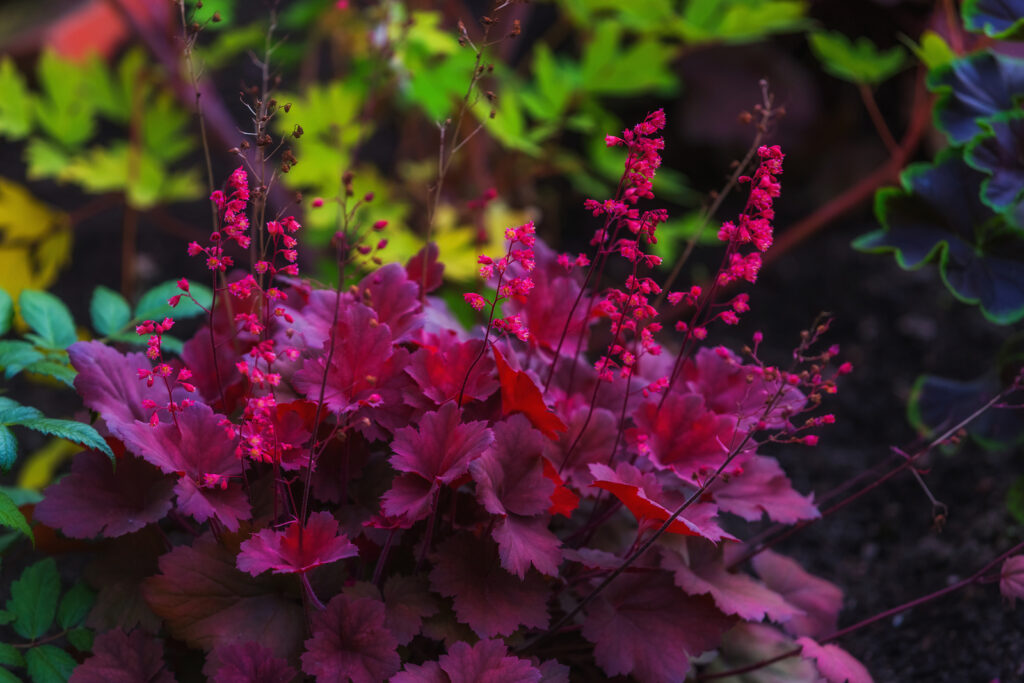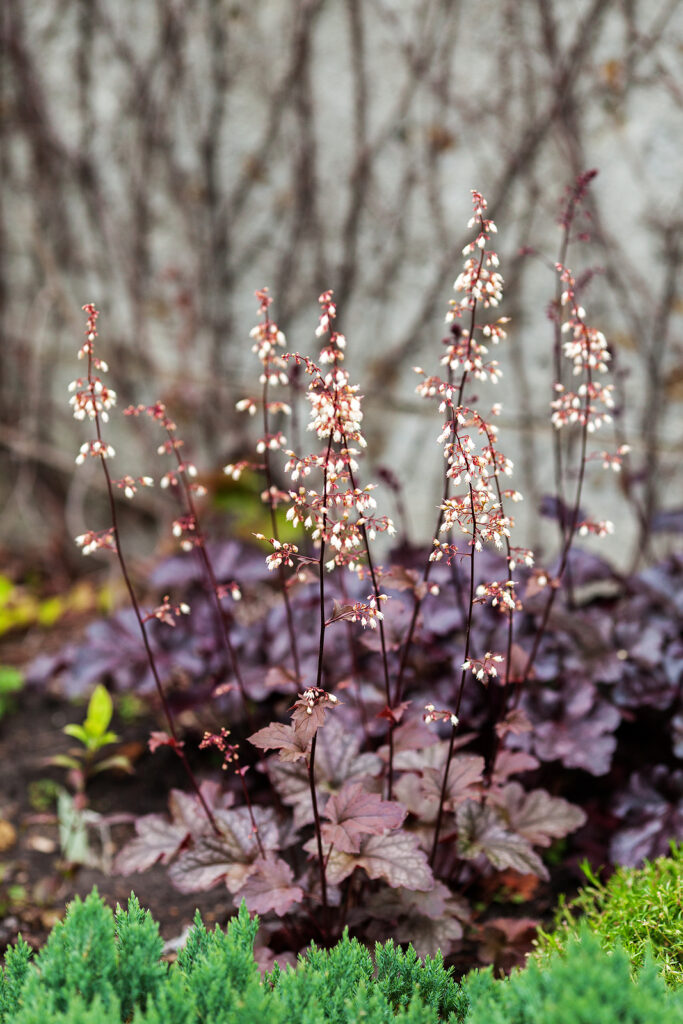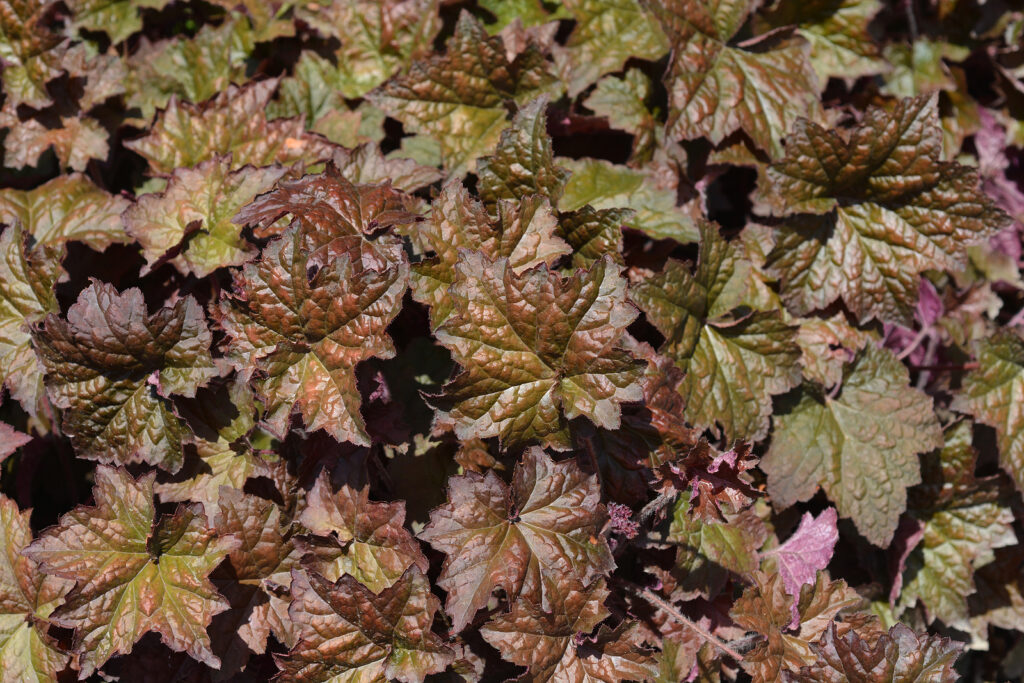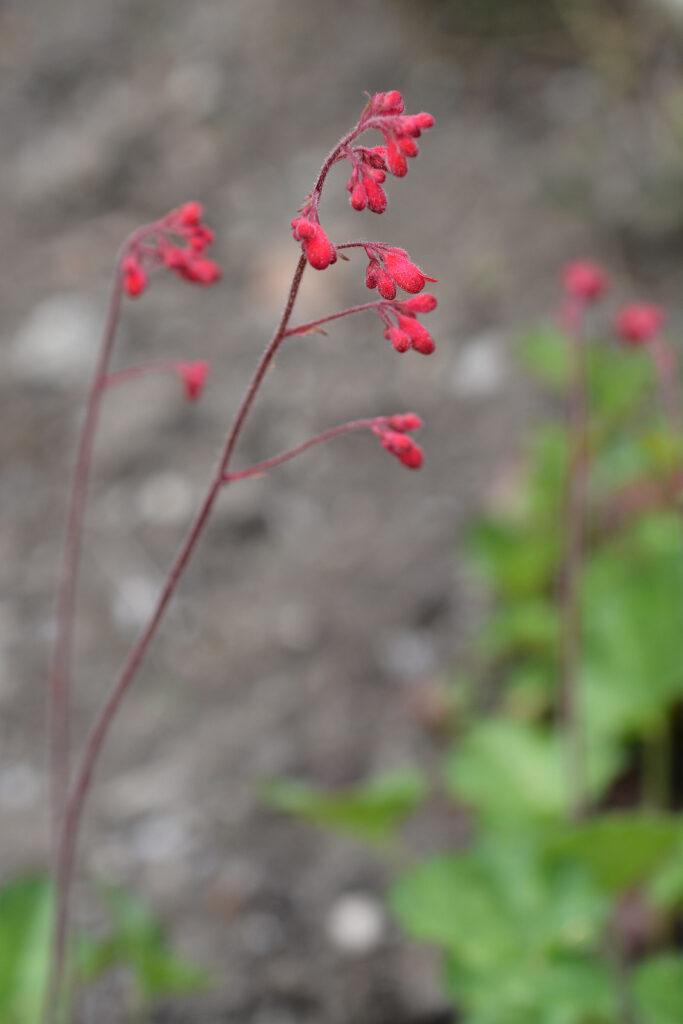Heuchera–commonly called coral bells–bears sprays of tiny, bell-shaped blooms in summer. Flowers rise on thin, wiry stems from a clump-forming, evergreen perennial with heart-shaped leaves that can be red, maroon, brown, yellow, or green.
Heuchera begins blooming in spring and continues into summer. Flowers remain on the plant for several weeks. Heuchera are nearly evergreen; the low basal rosettes have trim, rounded or kidney-shaped leaves. Leaves are usually green with red veins but some cultivars are reddish or purple.
Heuchera can be used as a ground cover or added in mass to beds and borders. It can be used as an edging plant with delphinium, iris, lilies, peonies, and roses.
Tools for Gardeners at Amazon:
- A.M. Leonard Straight Rake with Ash Handle
- All-Steel Nursery Spade with D-Grip Handle
- 4-Tine Spading Digging Fork with D-Handle
- Digital Soil pH Meter Outdoors Greenhouse
- Earthwise Handheld Electric Fertilizer Spreader
About 55 species belong to this genus of evergreen or semi-evergreen perennials. Heucheras grown for their flowers are called coral bells, while those grown for their foliage are typically referred to as alumroots or simply heucheras.

Get to know Heuchera
- Plant type: Perennial
- Growing Zones and range: Zones 3 to 9
- Hardiness: Hardy -30°F (-34°C)
- Height and width: 12 to 30 inches (30-76cm) tall; 12 inches (30cm) wide
- Foliage: Nearly round to heart-shaped, lobed and often toothed leaves
- Flowers: Wispy spikes of tiny bell-shaped flowers on wiry stems
- Flower colors: Pink, red, and white
- Bloom time: Spring into summer for many weeks
- Uses: Mass as groundcover; grows well in containers
- Garden companions: Combine with late-blooming bulbs
- Common name: Coral bells, alum root
- Botanical name: Heuchera spp.
- Family: Saxifragaceae
- Origin: North America Rocky Mountains
Where to plant Heuchera
- Grow Heuchera in the sun or part shade. Plant in full sun in Zones 3 to 5; plant in Zones 6 to 8 in partial shade.
- Plant Heuchera in humus-rich, well-drained soil; slightly alkaline soil is acceptable to coral bells.
- Heuchera prefers a soil pH of 6 to 7.
Heuchera uses and companions
- Use Heuchera as edging in formal and informal gardens.
- Use Heuchera as a groundcover or in an herbaceous or mixed, or shrub border.
- Heuchera combines well with pink, blue, and lavender flowers for a cool effect.
- Good companions for Heuchera include Campanula, Iris, Platycodon, Salvia, Sisyrichium striatum, Veronica.

When to plant Heuchera
- Set established Heuchera in the garden in spring or fall.
- Start seed indoors in spring after prechilling for 4 weeks in the refrigerator or outdoors at 40°F (4.4°C).
Planting and spacing Heuchera
- Start seed in a bright place at 70°F (21°C) on top of moist potting soil 2 inches (5cm) apart in flat or six-packs. Sprinkle a trace of sand over the seed.
- Germination takes about 21 days.
- Sow seed outdoors in the fall in a protected or cold frame for germination the following spring.
- Thin or transplant seedlings when they are 3 to 3 inches tall; transplant seedlings or plants into fresh-turned soil in spring or fall when the weather is cool.
- Space Heuchera 12 inches apart.
How to water and feed Heuchera
- Keep the soil evenly. Mature plants will tolerate a slight drought.
- Fertilize Heuchera every 6 weeks with an all-purpose fertilizer or work a 9-month slow-release fertilizer into the soil each spring.
- Remove spent flower stalks to encourage new blooms.
- Divide Heuchera every 3 to 4 years as needed.
- Heuchera is commonly pest and disease-free.

Heuchera care
- Mulch around Heuchera to conserve soil moisture.
- Remove flower stems after blooms are finished.
- Protect plant crowns in winter with a 2-inch layer of mulch around each plant.
Heuchera pests and diseases
- Mealybugs can be dislodged with a stream of soapy water or suffocated with dormant oil.
- Strawberry root weevil can be treated by soaking the roots with pyrethrum spray.
- Plants suffering stem rot should be uprooted and the diseased sections removed; treat the plant with a fungicide.
Heuchera propagation
- Divide large clumps in summer with a piece of stem attached. Replant divisions immediately.
- Take cuttings in summer with a piece of the main stem attached. Plant up to the leaf base in moist soil in shade. Move rooted plants to their permanent place in spring.
- Heuchera seeds germinate in 14 to 21 days at 65° to 70°F (18°-21°C).
Heuchera varieties to grow

- Heuchera americana, alumroot: Mounded plant to 24 inches (61cm) tall; flower stalks to 36 inches high with tiny greenish-white flowers; cultivars include ‘Garnet’ with deep red winter foliage, ‘Lace Ruffles’ with ruffled scalloped leaves mottled silvery-white, ‘Pewter Moon’ with purple leaves and strong central silvery zone, ‘Pewter Veil’ has silvery foliage.
- H. x brizoides: A group of hybrids between H. sanguninea and other species, often called Bressingham Hybrids; flowers in white and shades of pink and red.
- H. micrantha: Grows to 24 inches (61cm) tall; long-stalked roundish leaves that are toothed and lobed; flowers are whitish or greenish in loose clusters; hybrid forms developed from this species include ‘Palace Purple’ with maplelike leaves and dark purple foliage and ‘Ruffles’ with deeply lobed leaves that have ruffled edges.
- H. sanguinea: Most commonly grown variety; grows to 24 inches tall; bell-shaped bright red or coral pink flowers on wiry stems; some hybrids have yellow, pink, bronze, and silvery foliage.
Heuchera frequently asked questions
Q: What are the growing requirements for coral bells, Heuchera?
A: Coral bells are easily grown in moist, rich, well-drained loam, in full sun or light shade.
Q: Can I keep coral bells blooming?
A: Cutting off the spent stems of coralbells will cause flowers to be produced through summer, especially in areas with cool summer temperatures.
Q: When and how do I divide coralbells?
A: Coralbells need division only about every three or four years, particularly if mulched. Take up clumps in early spring or fall, and break them into pieces with as much root attached as possible. Replant about twelve inches apart.















